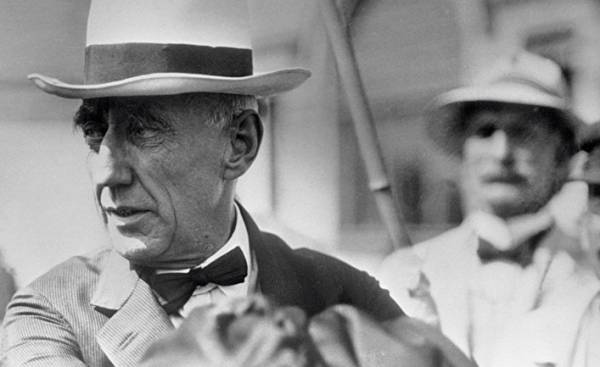
Roald Amundsen risked their lives to be remembered as a hero. “Poor RUAL,” says polar researcher and writer Monica Christensen.
Dressed in a thick woolen coat with images of polar bears, she stands in front of the Chalet Roald Amundsen on the banks of Bunnefjord in Svartskog.
The air is damp, cold to the bone, and she speaks with a man who is missing in the icy wilderness, nearly 90 years ago.
The house itself and everything in it has remained unchanged since that day in June 1928, when the bankrupt polar hero left it. His arch-rival, Umberto Nobile crashed with the airship “Italia” on the way to Spitsbergen via the North pole. Amundsen rushed to the rescue. Back home, he was not destined.
But for Christensen it look like he is still here: the man with sparse gray hair and tired gray-blue eyes on a rugged wrinkled face.
“So long I live with him and so loved that old man. It is very close to me. Don’t even know how many times a day I say, “Poor RUAL”.
I feel for him a feeling of great sympathy. We have in Norway for some reason you can’t have heroes without having to do the maximum in order to destroy them.
— Is easy to understand that you can see clear Parallels with the way treated you?
Yes. I understand it, says Christensen, who still experience post-traumatic stress syndrome after the public flogging in society, when she tried in the early 1990-ies to bring to Norway a tent penguins from the South pole.
Drop Amundsen
Her new book “the Last Amundsen’s journey” is dedicated not to the triumphs of the great Arctic Explorer from Norway, who first went North-West sea route, the first was at the South pole and, probably, was the first at the North pole.
The book describes his fall.
In the spring of 1928, the 55-year-old pensioner was Svartskog. He was very depressed, was very lonely, he was sad. He experienced a personal bankruptcy and was very weak after several courses of treatment for cancer. All the medals and plaques he put up for sale.
But he was still a name in the world. Although the famous photograph taken at the tent at the North pole in 1911, had faded.
New time brought with it a young polar heroes, and they differed significantly from it: fun, elegant, and understand the importance of media, they quickly did their stunts. Amundsen was out of date, turned into a kind of anachronism.
“Now, when the entire Arctic ocean could be crossed within a couple of days, that he, in fact, he proved that human courage and endurance was no longer so important. Old photos of people wearing hoods and warm clothes from the skins now seemed the Museum and even implausible,” Christensen wrote in his book.
Autobiography “My life polar Explorer,” published the year before, struck another blow to the reputation of the Amundsen. In the book he hypocritically and harshly attacked and all.
Italian Umberto Nobile, partner in charge of the expedition to the North pole on the airship “Norge”, was depicted as a good-for-nothing. Conceited braggart with a sour face, which has no polar experience, and having a very modest learning abilities.
“He has many times miraculously led us to death,” wrote Amundsen, which, according to Christensen, did not have the ability to forgive, and who didn’t realize how vindictive he seems himself.
“For him, a traitor was anyone who showed something other than blind loyalty and friendship. In the end, this category was most of his old friends,” she writes in her book.
In a letter to Fridtjof Nansen, the Norwegian Ambassador in London Benjamin Vogt (Benjamin Vogt) hinted that Amundsen was crazy. Nansen did not deny it.
“Like You, I think we are talking about the mental disorder of one sort or another, a kind of morbid nervousness, which, of course, manifested in different ways before,” he said.
The rescue expedition
And here is the airship of Nobile and his team of 15 people crashed. And Amundsen were suddenly able to regain the status of a hero.
“Immediately (Right away),” replied Amundsen, when the Minister of defence of Norway Torgeir Anderssen-Rysst (Torgeir Anderssen-Rysst) the same day, asked him to head a national rescue mission. To save his enemy — what could be nobler?
“He didn’t understand that in the eyes of the Norwegian public he had nothing else to prove. All my life Amundsen was lacking true love and respect from the Norwegian people. In 1928 what they already had, for the unknown,” writes Christensen.
But just a few days Amundsen pushed. Instead, the right to organize a rescue mission, the Norwegian government granted his old Deputy, the Risør Hjalmar Larsen (Hjalmar Riiser Larsen).
Amundsen was convinced that Risser Larsen took maneuvers behind him.
Humiliated and depressed, he decided to organize a private expedition. It was not easy for him. Sponsors and partners were weeded out one by one.
In the end, he was able to rent a French seaplane “Latham-47” and use the French crew of four. And he drew a Norwegian pilot Leif Dietrichson (Leif Dietrichson).
But almost all indicated that their efforts will be superfluous. Because really, Spitsbergen, and around the biggest, no doubt, a polar rescue expedition had been going on in full swing. It was attended by representatives of seven States.
“Maybe he ought to stay at home and make different statements, as did Otto Sverdrup, Fridtjof Nansen and other veterans.”
“But he didn’t feel comfortable to join other Arctic researchers. He was a man of action, and when the Newspapers began to write about his plans, still it was too late to reverse”.
“Suddenly he again became a hero, and the desire to be a hero is like a steel trap. As bonnets, which were worn in ancient times. Beautiful on the outside, but the inside was horribly pricked,” says Christensen.
“Feat”
When Amundsen 18 June 1928, took off from Tromso on the “Latham-47”, he, as usual, tightly hugging card. No one knew where he was going.
It is believed that he also wanted to try to localize a group of six persons from among the members of the expedition Nobile, those who were able to send a message about where they are approximately located in the drifting ice.
No one imagined, where there are three men who left camp in an attempt to reach land and get help.
Even less knew about the fate of the six men who flew after the collapse in detached unmanaged gondola of the airship “Italy”.
But, according to Christensen, it’s likely that Amundsen was a completely different plan.
“The only thing he could to save his reputation, is doing what was expected of him here in Norway, — a feat”.
“He could use the advantage that he had, because he acted alone. He didn’t have to adapt to some system, he was free to choose bolder alternatives than others of the expedition,” she writes.
“Turned defeat into victory”
Glaciers researcher Monica Christensen lives in a kind of symbiosis with the Amundsen since then, in the mid 1980-ies tried to go on his dog-sled and become the first woman to reach the South pole.
The attempt failed, she had to turn back before reaching the target of 450 kilometers, All resulted in millions of debt. But in the eyes of the Norwegian people it gained the status of a hero —a non-traditional polar Explorer.
Was given a gala performance in the Concert hall in Oslo, attended by the King of Olav.
“Monica Christensen is a phenomenon. She was able to turn lose — and it was, since it had not reached the South pole, in a big victory.”
“No one asks why it happened. That everything was poorly planned, was not even mentioned. Thanks to his wit and charm, she was able to remain a star on a national scale,” wrote VG, one of the few articles in the media, which did not mention the fact that she’s still blonde and beautiful.
But when Christensen in 1991 created a three-year research station in Antarctica and announced that one of the intermediate objectives of the expedition was to take the tent Amundsen left at the South pole and to return the cultural monument in Norway, the uproar.
“It’s the same as if the Americans were going to pick up the flag that Neil Armstrong planted on the moon in 1969,” said then, in particular, thrilled the Director of Public service of protection of monuments Stephan Tschudi-Madsen (Stephan Tschudi-Madsen).
The first attempt failed, but in 1993 she made a second.
“Turn back time”
The idea was to put the tent during the Olympic games in Lillehammer, which was to be held a year later. Prime Minister Gro Harlem Brundtland was among those who first endorsed the idea, but then the protests against the advertising trick became louder.
“Turn back time” and “Monica, leave the tent where it is” — such was then the headlines.
The Director of the Inspectorate according to George Apenes (Georg Apenes) believed that around the tent, insert the boom. The newspaper “Dagens Næringsliv” wrote about “the Fall of the Queen of ice”.
When the US began to claim that the project prevents environmental research in the Arctic, the Norwegian authorities asked her to roll the project.
But to surrender Christensen didn’t she had to do this only when the expedition ended in tragedy.
Deputy head of the expedition, Jostein Helgestad fell into a crevice between the ice and died. After returning home lenders filed Christensen multimillion-dollar lawsuits. Through the year the Fund went bankrupt.
Have to hang on the ropes
“After such a person cannot remain the same, but sometimes you have to make such a public flogging,” says Monica Christensen about how the media “pulled,” then and shall tell about the “Rumble in the jungle” Boxing match between Mohammedan Ali and George foreman in Zaire in 1974.
Everyone knew that Ali never had a chance; he couldn’t resist the bull foreman. But he just hung on the ropes, allowing them to take the blows while foreman is not threshed the air to such an extent that completely exhausted.
— This strategy is familiar to me. I also want to win the whole match, not the individual round.
How just was the criticism in your address?
— Much was true, and I never for a second did not try to shirk responsibility. But much of the criticism was unfair, and the pressure was so massive and lasted for so long. More than three years.
— You still hang on the ropes?
— I have PTSD and I have lost the sense of time.
— When I meet people, which last met ten years ago, it may seem that we talked to them the day before. But now I have more rope which I can hang, than it was then.
— Friends and relatives, publishers, and fellow writers. So sorry for me not worth it, she says.
Work on the book about Amundsen swallowed it all. In 1991, she said that working on his biography. Then she threw aside all the controversy surrounding the searches of the tent.
Now I instead wrote a portrait. The book is not the story of his life from the cradle to the grave; it is a question about the circumstances around his departure and disappearance, seen through the eyes of a tired polar Explorer, who craved love and tenderness, who last tried on the role of a hero and got on the plane.
— Just as there are artists — supporters of theatre experiences, I’m a writer, adhering to this method. I’m trying to be like those of whom I write.
A bit of polar history
• The airship “Italia” with a crew of 16 people, crashed on the ice North-East of the island Nordaustlandet (Nordaustlandet) during the return from the North pole to Spitsbergen on may 25, 1928. In this regard, was organized by the largest in the history of polar rescue expedition.
• More than 1,500 people from Denmark, Finland, France, Italy, Norway, Soviet Union, Sweden and the USA participated in the expedition, airplanes, ships and dog sleds. June 6, intercepted radio signals from Nobile, the search area was to delineate more precisely.
• Roald Amundsen and a crew of five on June 18 went on a quest but on the way from Tromso to French seaplane Latham disappeared. Attempts to find the wreckage in what have not resulted.
• Umberto Nobile and seven members of the crew of “Italy” in the end was saved, the last spent on a drifting ice floe 48 days. Two people were killed and another six disappeared without a trace.
Unknown death
When Amundsen went missing, there are three main theories:
• The plane crashed near the Bear island.
• The plane had technical problems, he tried to return to the Norwegian coast, but collapsed.
• The plane crashed on the way to the balloon, near the campground Nobile.
Subsequently, the first theory became official. “Amundsen was killed near Bear island”, it is written in encyclopedias.
Death caught him just as he wanted, than just a few days earlier said in an interview with Italian journalist:
“Oh! If You only knew how Grand up there! That’s where I wanted to die, I just wish death had came for me in a chivalrous way, during the execution of some job, that all ended quickly and without suffering.”
After the fall was found a few fragments, Newspapers have published obituaries, and during official ceremonies in the Auditorium of the University of Oslo in December Nansen made his famous speech in memory of Amundsen:
“And then when it was done, he returned to the expanse of the Arctic ocean, where it was the case throughout his life. He found an unknown grave under the clear sky, the Kingdom of ice, where the noise of the wings of eternity.”
“But from a vast, white silence his name will be for hundreds of years to light the way for the youth of Norway in all the splendor of the Northern lights”.
“Such people, courageous, strong-willed as he gives us faith in our family, give hope for the future. A world that gives birth to such sons are still young”.
Theory Christensen
Christensen, by contrast, has long of the most trusted third theory:
Most of all he was worried about those who remained divorced unmanaged gondola of the airship. Before leaving, he said to Aftenposten that they most need help.
Four of them he knew personally, they took part in the expedition “Norway”. The “Latham” range was more than sufficient to fly there and then fly South, Nu-Alesund.
And then Christensen natural question arose: what if Amundsen accidentally found part of the airship at the North-East of Spitsbergen, landed a seaplane in a hole and survived?
Gradually she found quite reasonable evidence that so could well be.
The gas tank of the plane “Latham”, which was found in pretty decent condition? He wouldn’t be in this state, if the plane suffered a complete collapse, concluded Christensen.
And was it not more obvious that the crew unscrewed the tanks and began to use the plane as a rescue boat, she asked herself.
The volume of consumed fuel correspond to the distance. The call, which allegedly took Central station on Svalbard in the night of 19 June, also suggested that Amundsen might well be there.
“Poor RUAL, you sat there and rocked in the waves,” thought Christensen.
Until last summer, it was just exercises to train your brain. But then she managed to experience the strongest in your life insight.
“Everything fell into place”
29 Jun 2016. Christensen family is in Cambridge, the city where she received a doctorate in glaciology, the next day they were going to celebrate her 66th birthday.
Work on the book about Amundsen is almost completed, there are a couple of finishing touches. So she decides to call the Institute of polar studies named Scott (Scott Polar Research Institute) to check the last few links.
One of them concerns British student expedition to Nordaustlandet in 1935-1936 First in archive can’t find the report. When they eventually find him, he finds himself in the book that’s in the wrong place and upside down.
Christensen takes the book, sits at a small Desk by the window. It is accepted for reading, and it began to tremble.
Because it tells about how the students came across the remains of camp in a small Bay on the Peninsula Ripalvella (Rijphalvøya) to Spitsbergen in 1936.
There they found some Italian papers, wrappers from chocolate, dry bread, remnants of the Norwegian Newspapers, and a large piece of rubberized cotton fabric — that were used in airships and balloons.
Yellow square with traces of dead vegetation was talking about the fact that the tent has been there for a long time.
“It was amazing. Suddenly the curtain opened, everything fell into place. This happens perhaps only once in a lifetime. I asked the staff, do they realize what a gold mine sit. They had no idea”.
Because, according to Christensen, to put the camp could only two groups: either six disappeared in the gondola of the balloon, or the crew of “the Latham-47”.
And she is convinced that the second option most likely.
Ready the answer is no
It suggests that the crew “of Latham-47” some time was in the same place and the balloon and tried to repair the plane.
Perhaps they succeeded, they took off, but there was no fuel, and they landed on the open water. Perhaps they used the “Latham-47” as a lifeboat. She doesn’t know.
However, she has no doubt that they are, after all, headed on foot to the place where British students eight years later discovered the camp.
Have you managed to survive to some of the Italians from the airship? Probably not. Christensen thinks that, in order to prove that they found them, Amundsen and Co. took a piece of fabric from the airship and some Italian documents.
When the operation of searching for “Italy” and “Latham-47” was completed, eight people were saved: two of the three who, in desperation, set off on the ice for assistance, as well as Nobile and five of the camp. The latest at the time when they were taken, conducted in the pack ice 48 days.
17 people died: One when “Italy” was wrecked, six were carried out on detached unmanaged airship, one of the three who left the camp in the hope to reach out to people; Amundsen, Dietrichson and four others on Board, “Latham-47”, and three crashed into a power line, after returning back home to Italy.
But the final answer is no and no.
We don’t know a lot of things. But my theory is reinforced by the fact that the participants in all the search expeditions say that I found British students, they did not belong, and that while in that area there were no hunters.
— I’ve read all the materials about expeditions to Spitsbergen from 1928 to 1936, Dutch, English and Italian. Anyone else in the area was no more, she says.
“Let’s talk!”
— So what happened to Amundsen in the end?
— I think he could hold out until the end of winter. But where he and the others left, leaving the camp, is a mystery.
— How do you think will be perceived by your new theory?
— Very skeptical. While my theory, only one supporter, and I did it myself. In it’s possible that I’m wrong. So my call is this: “Let’s talk!”
— I hope that book — no matter what — will help to ensure that Roald Amundsen of Norway will be treated with great respect. You deserve it, poor RUAL.
— And you were already in his last expedition?
66-year-old woman leans on the crutches, which is forced to go after making his way in a snowstorm during a recent trip to Svalbard have further damaged the nerve endings on the feet. Responds quickly and decisively:
— Is! No one goes to his last expedition. Go to the next.
“Interesting theory”
Tour Bomann Larsen (Tor Bomann Larsen) (the author of the book “Roald Amundsen biography”).
— It is a hypothesis, and until it is issued for something more all right.
More just shocking that it’s been almost 90 years after the disappearance of Amundsen, but still gather evidence and line up the theories about his death.
— It is said that Roald Amundsen immortal. And Monica Christensen. Honor and praise!
Alexander Wisting (Alexander your needs wisting), the author of the book “Roald Amundsen: The big gamble”).
— I would not deny the possibility that Amundsen could survive the crash. Description of the finds made at the alleged camp may point to his trail.
— I think the theory of Monica’s well reasoned and interesting. They provide an opportunity to reflect on the fact that Amundsen could go on and on.
— Maybe there are still some traces?






